Analysis of Dynamic Response Behavior of Crack under Impact Stress Wave
Abstract
1. Introduction
2. Stress Wave Propagation Equation in Metal
2.1. Wave Equation of Material under Stress Wave
2.2. Crack Dynamic Response under İmpact Load
3. Numerical Simulation Process and Result Analysis
3.1. Establishment of Finite Element Model
3.2. Dynamic Stress intensity factor
3.3. Numerical Simulation Results and Analysis
3.3.1. Wave Propagation Modeling using Explicit FEA
3.3.2. Numerical Simulation of Stress Wave Propagation in the CT Sample under Impact
3.3.3. Numerical Simulation Analysis of Crack Growth under Impact Load
4. Conclusions
- Based on wave theory, the evolutionary characteristics of shock stress wave behavior were explored;
- A characterization method for the dynamic response of metallic materials under impact load was proposed, and a shock stress wave propagation model was established;
- Through the numerical simulation of 2A12 aluminum alloy under the impact load, combined with the established wave equation, the characterization of the shock stress wave behavior was conducted;
- At the same time, the fluctuation of the evolutionary characteristics of a shock stress wave at different defects was researched. Aimed at the dynamic response behavior of the stress and strain field at the crack tip, the dynamic fracture strength stress factor was introduced to conduct the dynamic fracture performance evaluation of the crack-damaged structure under shock waves. Numerical analysis of CT samples loaded by SHPB dynamic tie rods demonstrated that the stress wave quickly reached a state of stress equilibrium in the metal component, and the crack had begun to crack before the stress intensity factor reached the maximum.
Author Contributions
Funding
Institutional Review Board Statement
Informed Consent Statement
Data Availability Statement
Acknowledgments
Conflicts of Interest
References
- Oda, J.; Murotsu, Y. (Eds.) Mechanical Design Engineering (I), Element & Design; Baifukan: Tokyo, Japan, 2000; Volume 5. [Google Scholar]
- Gerlach, R.; Siviour, C.R.; Petrinic, N.; Wiegand, J. Experimental characterisation and constitutive modelling of RTM-6 resin under impact loading. Polymer 2008, 49, 2728–2737. [Google Scholar] [CrossRef]
- Dannemann, K.A.; Chalivendra, V.B.; Song, B. Dynamic behavior of materials. Exp. Mech. 2012, 52, 117–118. [Google Scholar] [CrossRef]
- Ramesh, K.T. High Rates and Impact Experiments. In Springer Handbook of Experimental Solid Mechanics; Springer Handbooks; Sharpe, W., Ed.; Springer: Boston, MA, USA, 2008. [Google Scholar] [CrossRef]
- Florando, J.N.; Jiao, T.; Grunschel, S.E.; Clifton, R.J.; Lassila, D.H.; Ferranti, L.; Becker, R.C.; Minich, R.W.; Bazan, G. High Rate Plasticity Under Pressure Using a Windowed Pressure-Shear Impact Experiment; American Institute of Physics: College Park, MD, USA, 2009; pp. 723–726. [Google Scholar]
- Menard, K.P.; Menard, N.R. Dynamic Mechanical Analysis, 3rd ed.; CRC Press: Boca Raton, FL, USA, 2020. [Google Scholar] [CrossRef]
- Radović, A.; Radovanović, J. Dynamic analysis and response of systems under impact loads. In Proceedings of the 6th International Conference on Contemporary Achievements in Civil Engineering, Subotica, Serbia, 20 April 2018. [Google Scholar] [CrossRef]
- Horn, J.-T.; Krokstad, J.R.; Leira, B.J. Impact of model uncertainties on the fatigue reliability of offshore wind turbines. Mar. Struct. 2019, 64, 174–185. [Google Scholar] [CrossRef]
- Dodd, R.K.; Eilbeck, J.C.; Gibbon, J.D.; Morris, H.C. Soliton and Nonlinear Wave Equations; Academic Press: Cambridge, MA, USA, 1982. [Google Scholar]
- Mc Kean, H.P.; Vaninsky, K.L. Statistical mechanics of nonlinear wave equations. In Trends and Perspectives in Applied Mathematics; Springer: New York, NY, USA, 1994; pp. 239–264. [Google Scholar]
- Engelbrecht, J. Wave equations in mechanics. Est. J. Eng. 2013, 19, 273–282. [Google Scholar] [CrossRef]
- Wheeler, G.F.; Crummelt, W.P. The vibrating string contraversy. Am. J. Phys. 1987, 55, 33–37. [Google Scholar] [CrossRef]
- van Hoof, J.F.A.M. One and Two Dimensional Wave Propagation in Solids. WFW Reporter, 1994. Available online: https://research.tue.nl/en/studentTheses/one-and-two-dimensional-wave-propagation-in-solids (accessed on 31 October 2021).
- Shantharaja, M.; Sandeep, G.M. Experimental and numerical analysis of propagation of stress wave in sheet metal. Int. J. Sci. Technol. Res. 2014, 3, 40–42. [Google Scholar]
- Sandeep, G.M.; Avinash, D.N. A Comparative Study on Behavior of Stress Wave Propagation in Different Sheet Metals under Impact Loads. Int. J. Eng. Res. Technol. (IJERT) Etmet 2016, 4. Available online: https://www.ijert.org/a-comparative-study-on-behavior-of-stress-wave-propagation-in-different-sheet-metals-under-impact-loads (accessed on 31 October 2021).
- Kolsky, H.; Douch, L.S. Experimental studies in plastic wave propagation. J. Mech. Phys. Solids 1962, 10, 195–223. [Google Scholar] [CrossRef]
- Sadighi, M.; Pärnänen, T.; Alderliesten, R.; Sayeaftabi, M.; Benedictus, R. Experimental and numerical investigation of metal type and thickness effects on the impact resistance of fiber metal laminates. Appl. Compos. Mater. 2012, 19, 545–559. [Google Scholar] [CrossRef]
- Seife, C. Seventeen Equations That Changed the World; Times Higher Education: London, UK, 2012. [Google Scholar]
- Wang, L. Tide Wave Basics [M], 2nd ed.; National Defense Industry Press: Beijing, China, 2005. [Google Scholar] [CrossRef]
- Friedrichs, K.O. Asymptotic phenomena in mathematical physics. Bull. Am. Math. Soc. 1955, 61, 485–504. [Google Scholar] [CrossRef]
- French, A.P. Vibrations and Waves, 1st ed.; CRC Press: Boca Raton, FL, USA, 1971. [Google Scholar] [CrossRef]
- Leppänen, J. Splitterverkan; (Report: MSB345); Myndigheten för Samhällskydd Och beredskap: Karlstad, Sweden, 2012. [Google Scholar]
- Tell, F.; Svensson, T. Stress Wave Propagation between-Different Materials. Master’s Thesis, Chalmers University of Technology, Gothenburg, Sweden, May 2015. [Google Scholar]
- Khodaei, Z.S.; Aliabadi, M.H. Assessment of delay-and-sum algorithms for damage detection in aluminium and composite plates. Smart Mater. Struct. 2014, 23, 075007. [Google Scholar] [CrossRef]
- Dennis, G. Physics of Shock and Impact; IOP Publishing: Bristol, UK, 2017. [Google Scholar] [CrossRef]
- Meyers, M.A.; Thadhani, N.N.; Yu, L.H. Shock waves for industrial applications. Noyes: Hammonton, NJ, USA, 1988; p. 265. [Google Scholar]
- Ha, Y.D.; Bobaru, F. Studies of dynamic crack propagation and crack branching with peridynamics. Int. J. Fract. 2010, 162, 229–244. [Google Scholar] [CrossRef]
- Gao, L.; Liu, K.; Ying, L. A meshless method for stress-wave propagation in anisotropic and cracked media. Int. J. Eng. Sci. 2007, 45, 601–616. [Google Scholar] [CrossRef]
- Tian, Z.; Huo, L.; Gao, W.; Li, H.; Song, G. Modeling of the attenuation of stress waves in concrete based on the rayleigh damping model using time-reversal and put transducers. Smart Mater. Struct. 2014, 23, 075007. [Google Scholar]
- Liu, K.; Gao, L.; Tanimura, S. Application of discrete element method in impact problems. JSME Int. J. 2005, 47, 138–145. [Google Scholar] [CrossRef][Green Version]
- Azari, H.; Nazarian, S.; Yuan, D. Assessing the sensitivity of impact echo and ultrasonic surface waves methods for nondestructive evaluation of concrete structures. Constr. Build. Mater. 2014, 71, 384–391. [Google Scholar] [CrossRef]
- Dziedziech, K.; Pieczonka, L.; Kijanka, P.; Staszewski, W.J. Enhanced nonlinear crack-wave interactions for structural damage detection based on guided ultrasonic waves. Struct. Control Health Monit. 2016, 23, 1108–1120. [Google Scholar] [CrossRef]
- Carino, N.J. Stress Wave Propagation Methods; CRC Press: Boca Raton, FL, USA, 2003. [Google Scholar]
- Owen, D.M.; Zhuang, S.; Rosakis, A.J.; Ravichandran, G. Experimental determination of dynamic crack initiation and propagation fracture toughness in thin aluminum sheets. Int. J. Fract. 1998, 90, 153–174. [Google Scholar] [CrossRef]
- Rittel, D.; Maigre, H. An investigation of dynamic crack initiation in Emma. Mech. Mater. 1996, 23, 229–239. [Google Scholar] [CrossRef]
- Yue, Z.W.; Yang, R.S.; Guo, D.M.; Cao, H.; Dong, J.C. Dynamic analysis of crack propagation in media containing flaws under the explosive stress wave. Rock Soil Mech. 2009, 30, 949–954. [Google Scholar]
- Cui, X.; Fan, Y.; Wei, J.I.; Chen, J. Progress in the research of dynamic fracture toughness based on hopkinson Hopkinson bar technique. Ordnance Mater. Sci. Eng. 2010, 32, 118–122. [Google Scholar]
- Li, H.; Wong, L. Influence of flaw inclination angle and loading condition on crack initiation and propagation. Int. J. Solids Struct. 2012, 49, 2482–2499. [Google Scholar] [CrossRef]
- Truesdell, C.; Noll, W. The non-linear field theories of mechanics. In The Non-Linear FIELD Theories of Mechanics; Springer: Berlin/Heidelberg, Germany, 2004; pp. 1–579. [Google Scholar]
- Engelbrecht, J. Nonlinear Wave Dynamics: Complexity and Simplicity; Springer Science & Business Media: Berlin, Germany, 2013; Volume 17. [Google Scholar]
- Meyers, M.A.; Murr, L.E. Propagation of Stress Waves in Metals; Springer: Amsterdam, The Netherlands, 1983. [Google Scholar]
- Noël, J.P.; Renson, L.; Grappasonni, C.; Kerschen, G. Dynamic Behavior of Materials; Springer: New York, NY, USA, 2016. [Google Scholar]
- Bolt, B.A. Seismic input motions for nonlinear structural analysis. ISET J. Earthq. Technol. 2004, 41, 223–232. [Google Scholar]
- Barkan, D.D. Dynamics of Bases and Foundations; McGraw-Hill: New York, NY, USA, 1948; Volume 1962, 434p. [Google Scholar]
- Sansalone, M.; Carino, N.J.; Hsu, N.N. A finite element study of transient wave propagation in plates. J. Res. Natl. Bur. Stand. 1987, 92, 267–278. [Google Scholar] [CrossRef]
- Chen, F.; Shield, R.T. Conservation laws in elasticity of the J-integral type. Z. Angew. Math. Phys. 1977, 28, 1–22. [Google Scholar] [CrossRef]
- Schwalbe, K.H. Comparison of several fatigue crack propagation laws with experimental results. Eng. Fract. Mech. 1974, 6, 325–341. [Google Scholar] [CrossRef]
- Li, X.; Lu, X.; Li, M.; Hao, J.; Xu, Y. Numerical Study on Evaluating the Concrete-Bedrock Interface Condition for Hydraulic Tunnel Linings Using the SASW Method. Appl. Sci. 2018, 8, 2428. [Google Scholar] [CrossRef]
- Zhao, H.; Gary, G. On the use of SHPB techniques to determine the dynamic behavior of materials in the range of small strains. Int. J. Solids Struct. 1996, 33, 3363–3375. [Google Scholar] [CrossRef]
- Zhang, W.; Gang, W.; Xiao, X. The constitutive relationship and failure model of 2A12 aluminum alloy. Acta Armamentarii 2013, 34, 276–282. [Google Scholar]
- Ramulu, P.J. Aluminum Alloys Behavior during Forming. Aluminium Alloys and Composites; IntechOpen: Adama, Ethiopia, 2019. [Google Scholar]
- Liu, J.; Shao, X.J.; Liu, Y.S.; Yue, Z.F. Effect of cold expansion on fatigue performance of open holes. Mater. Sci. Eng. A 2008, 477, 271–276. [Google Scholar] [CrossRef]
- ABAQUS/Standard User’s Manual; Version 6.1; HKS Inc.: Providence, RI, USA, 2000.
- Chen, G. A method of incident pulse shaping for SHPB. WIT Trans. Built Environ. 2014, 141, 181–189. [Google Scholar]
- Kishimoto, K.; Aoki, S.; Sakata, M. Simple formula for dynamic stress intensity factor of pre-cracked Charpy specimen. Eng. Fract. Mech. 1980, 13, 501–508. [Google Scholar] [CrossRef]
- Li, C. Experimental Study on the Constitutive Relationship of 2A12 Aluminum Alloy; Harbin Institute of Technology: Harbin, China, 2006. [Google Scholar]
- Kishimoto, K.; Aoki, S.; Sakata, M. On the path independent integral-j. Eng. Fract. Mech. 1980, 13, 841–850. [Google Scholar] [CrossRef]
- Nishioka, T. Computational dynamic fracture mechanics. Int. J. Fract. 1997, 86, 127–159. [Google Scholar] [CrossRef]
- Rice, J.R. A Path Independent Integral and the Approximate Analysis of Strain Concentration by Notches and Cracks. J. Appl. Mech. 1968, 35, 379–386. [Google Scholar] [CrossRef]
- Zhou, H.-L. The derivation of the relationship between J integral and KI in view of the plane stress state. J. Chongqing Jiaotong Univ. 2006, 02, 35–37. [Google Scholar]
- Sun, H.; Zhu, J. Monitoring early age properties of cementitious material using ultrasonic guided waves in embedded rebar. J. Nondestruct. Eval. 2017, 36, 5. [Google Scholar] [CrossRef]
- Moreno-Garcia, P.; Lopes, H.; Araujo, d.S.J.V. Application of higher-order finite differences to damage localization in laminated composite plates. Compos. Struct. 2016, 156, 385–392. [Google Scholar] [CrossRef]
- Moll, J.; Golub, M.V.; Glushkov, E.; Glushkova, N.; Fritzen, C.P. Non-axisymmetric lamb wave excitation by piezoelectric wafer active sensors. Sens. Actuators A Phys. 2012, 174, 173–180. [Google Scholar] [CrossRef]
- Peng, H.; Meng, G.; Li, F. Modeling of wave propagation in plate structures using three-dimensional spectral element method for damage detection. J. Sound Vib. 2009, 320, 942–954. [Google Scholar] [CrossRef]
- Ham, S.; Bathe, K.J. A finite element method enriched for wave propagation problems. Comput. Struct. 2012, 94–95, 1–12. [Google Scholar] [CrossRef]
- Stojić, D.; Nestorović, T.; Marković, N.; Marjanović, M. Experimental and numerical research on damage localization in plate-like concrete structures using hybrid approach. Struct. Control Health Monit. 2018, 25, e2214. [Google Scholar] [CrossRef]
- Li, H.; Li, J.; Huang, Y. A review of the extended finite element method on macrocrack and microcrack growth simulations. Theor. Appl. Fract. Mech. 2018, 97, 236–249. [Google Scholar] [CrossRef]
- Prabel, B.; Combescure, A.; Gravouil, A.; Marie, S. Level set X-FEM non-matching meshes: Application to dynamic crack propagation in elastic–plastic media. Int. J. Numer. Methods Eng. 2007, 69, 1553–1569. [Google Scholar] [CrossRef]
- Remmers, J.J.; de Borst, R.; Needleman, A. The simulation of dynamic crack propagation using the cohesive segments method. Opt. Commun. 2008, 56, 70–92. [Google Scholar] [CrossRef]
- Guo, L.; Zhong, W.; Chen, Z.; Luo, J. Numerical simulation of dynamic crack propagation process of magnesium-aluminum alloy under impact load. Explos. Shock. 2016, 36, 7. [Google Scholar]
- Wu, L.; Zhang, L.X.; Guo, Y.K. A review of the extended finite element for fracture analysis of structures. In Applied Mechanics and Materials; Trans Tech Publications Ltd.: Wollerau, Switzerland, 2014; Volume 444. [Google Scholar]
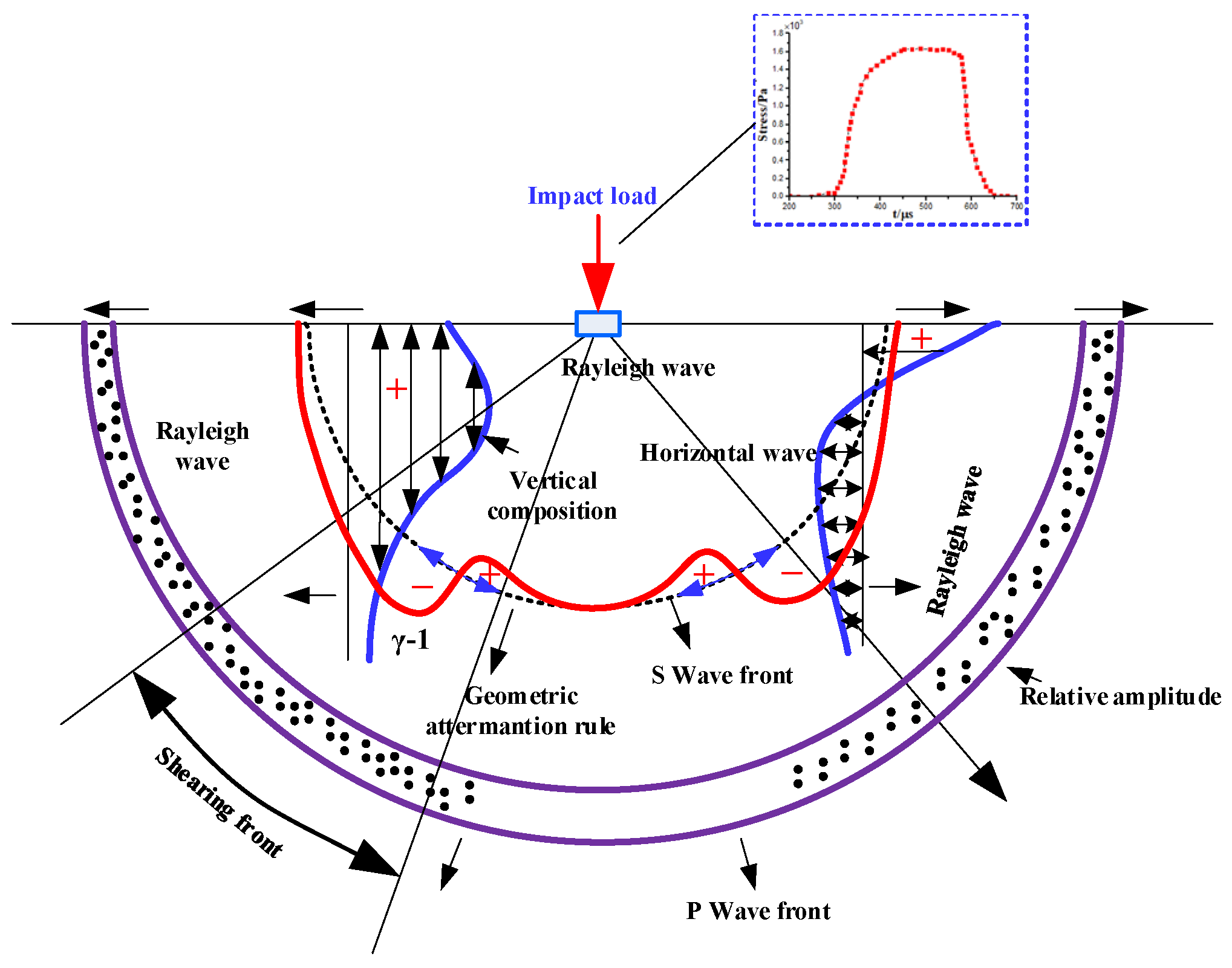
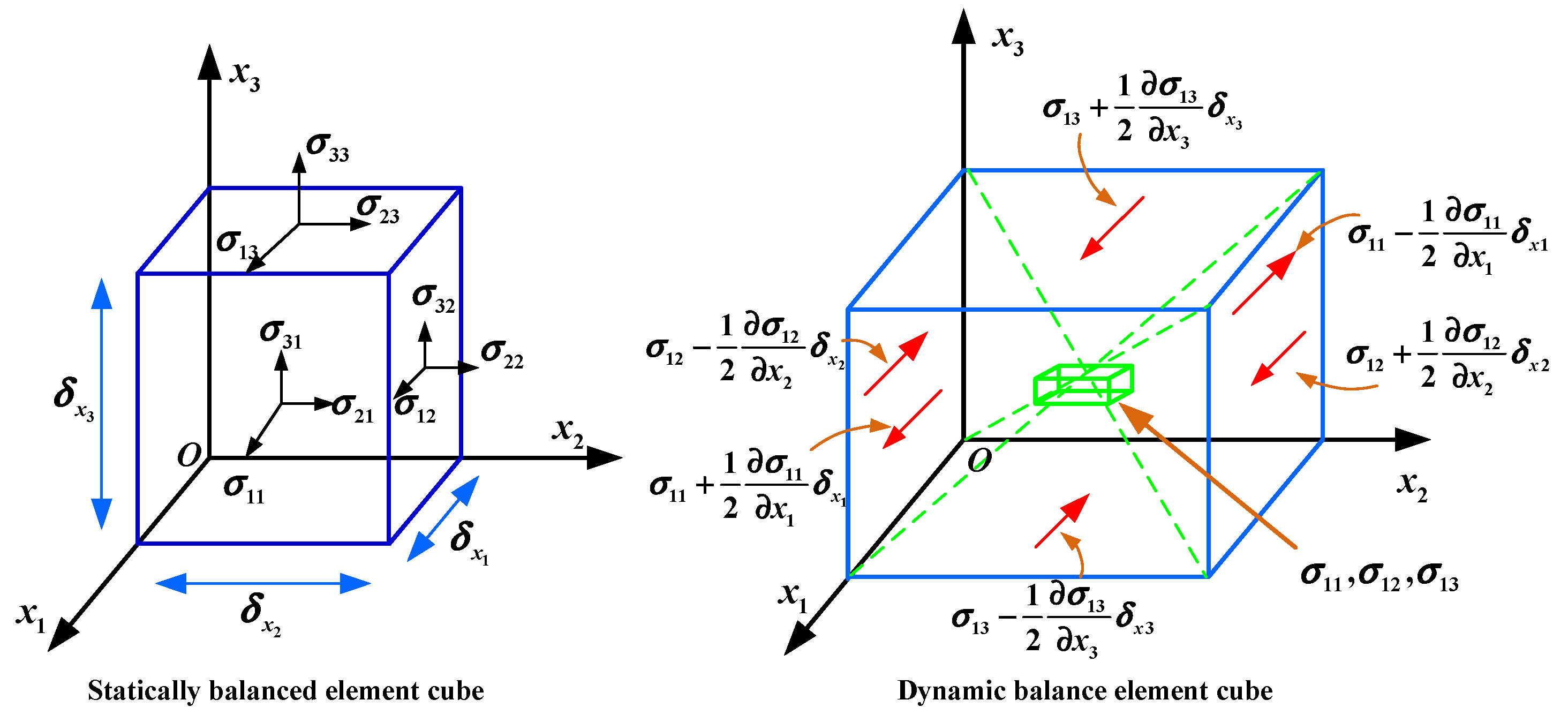
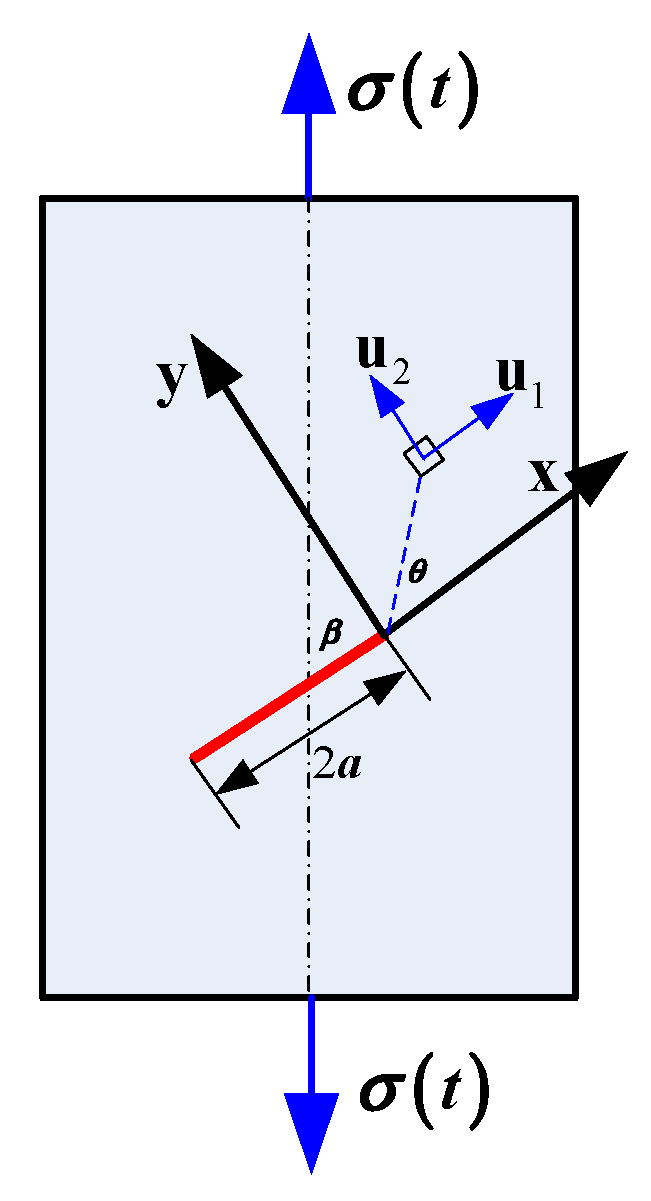
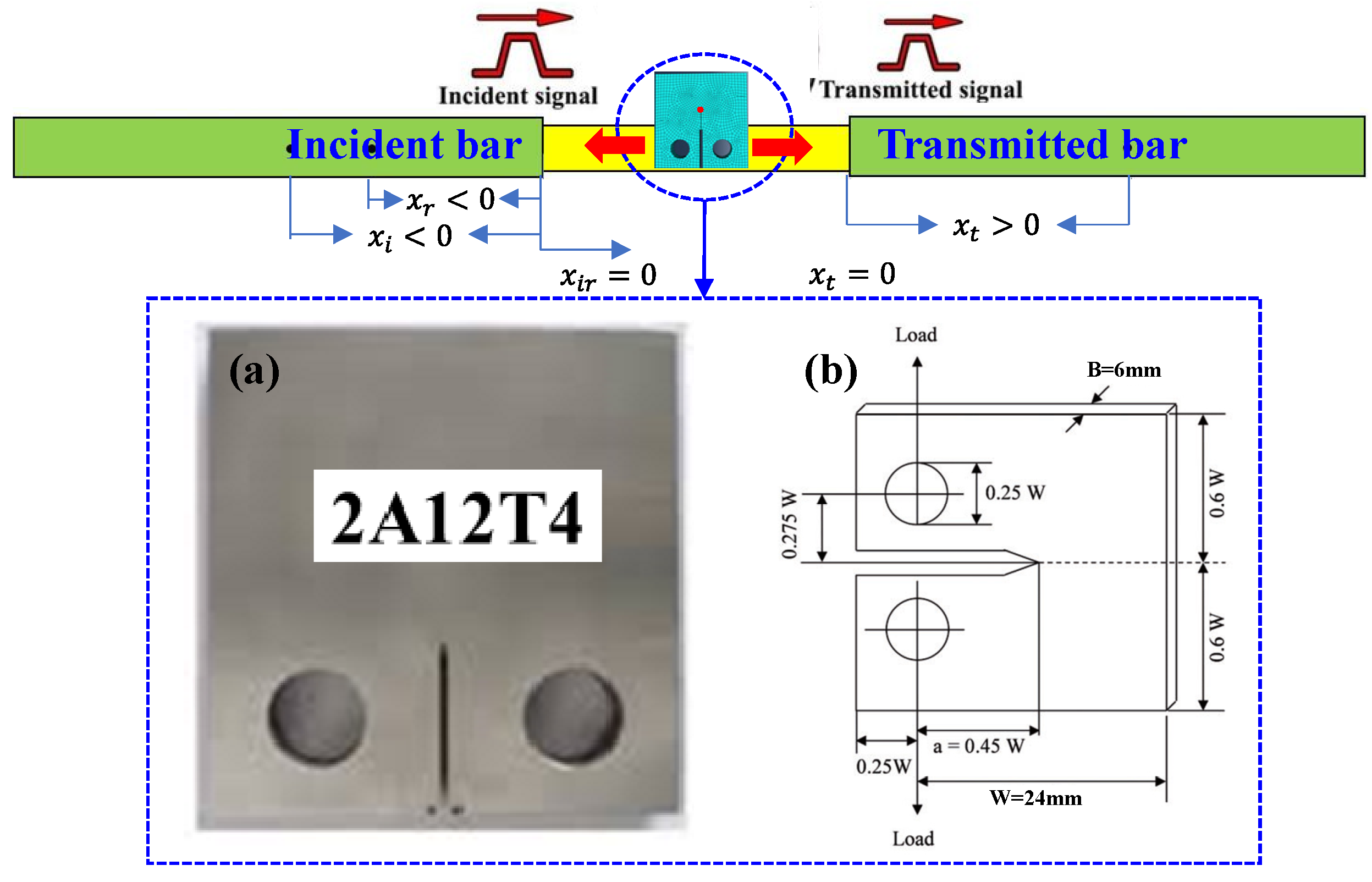
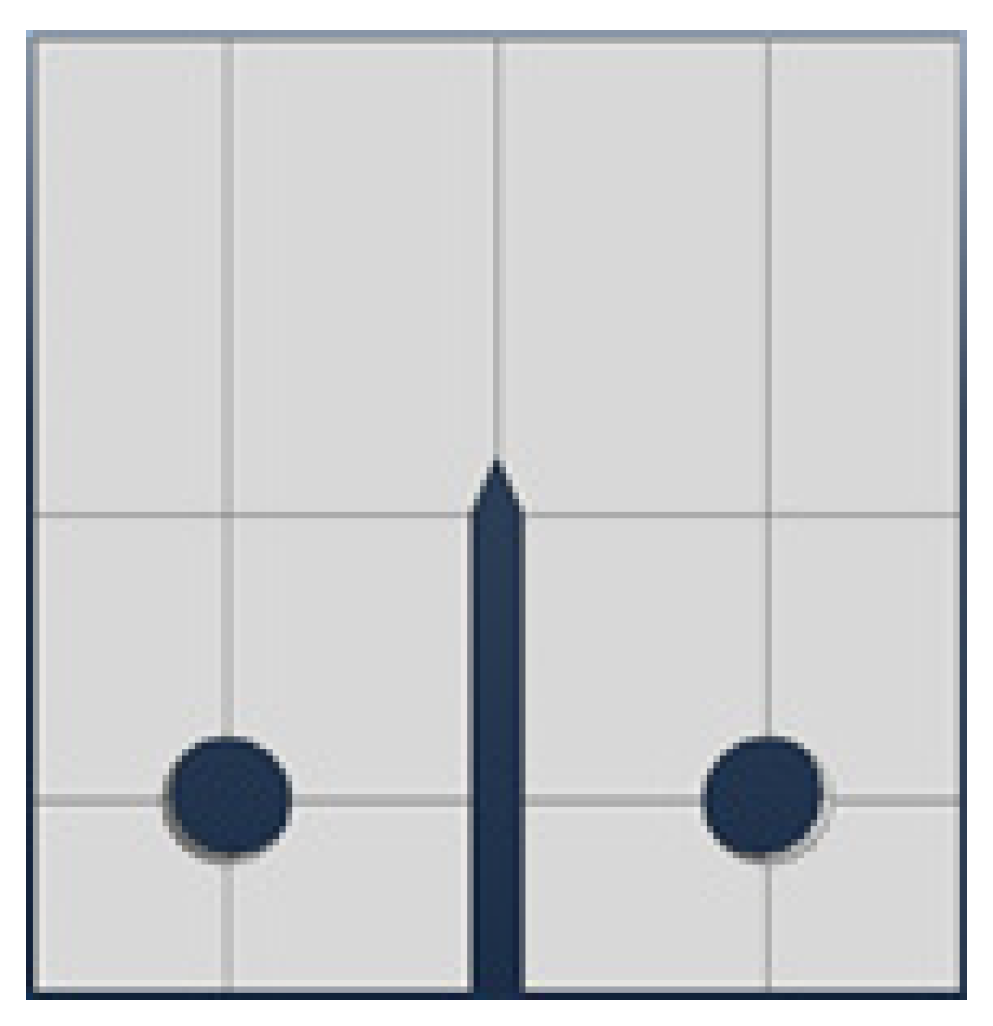
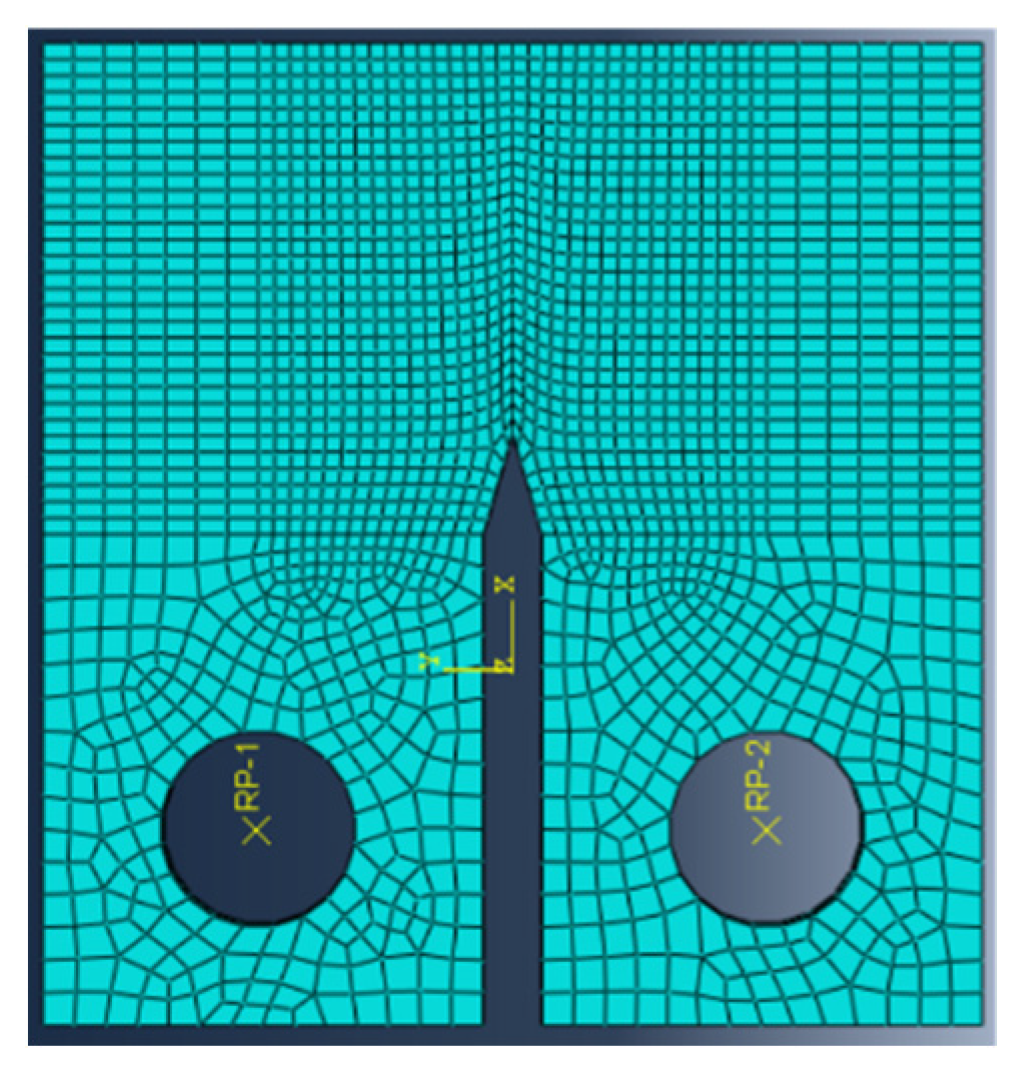
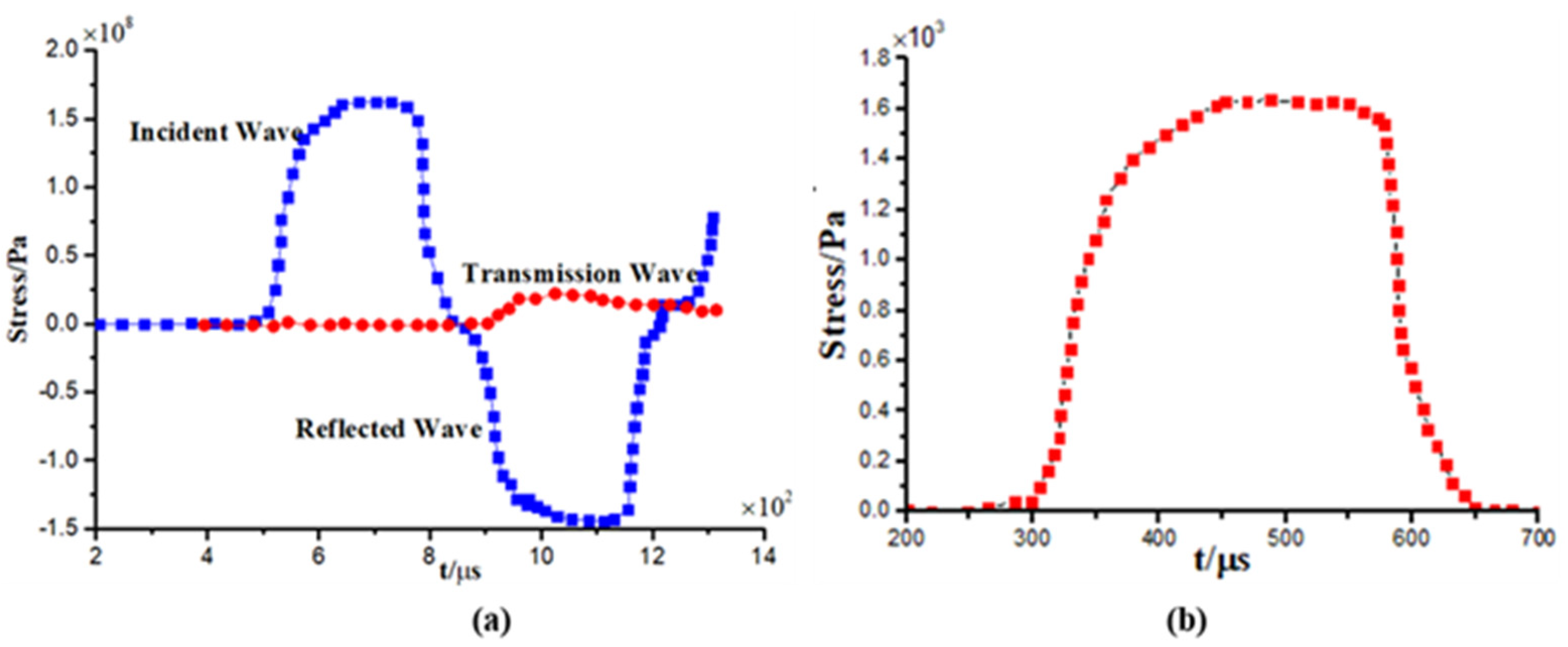
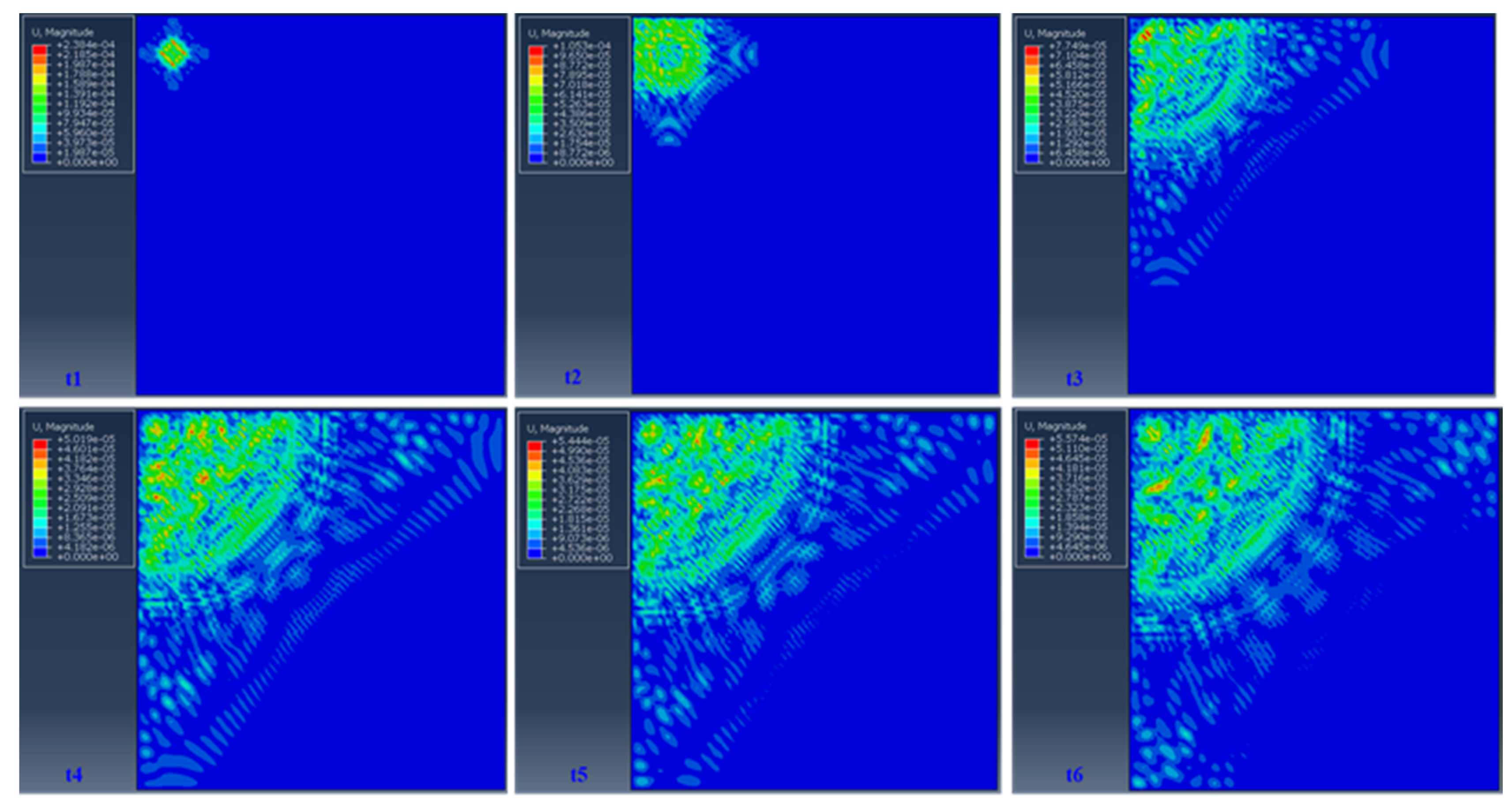
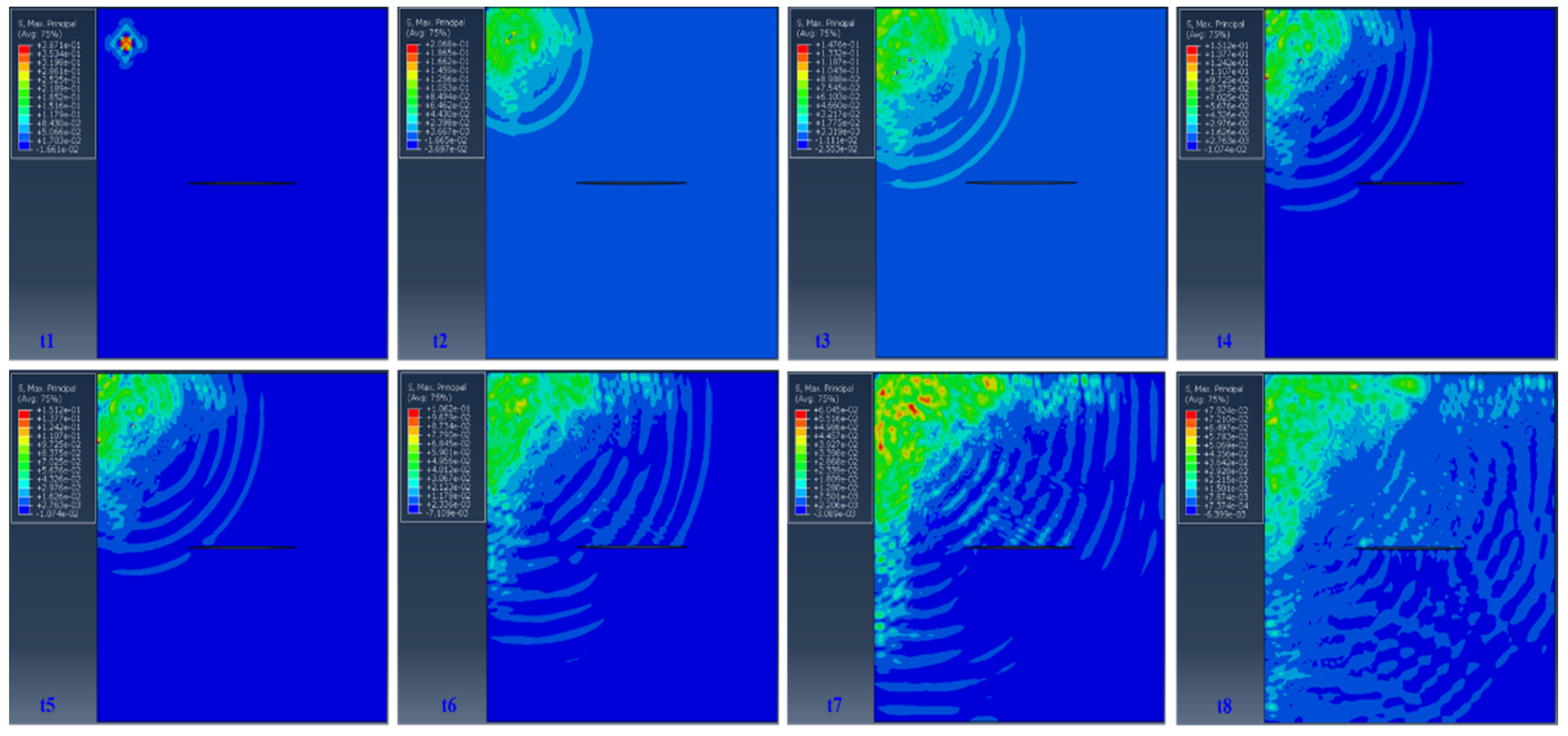
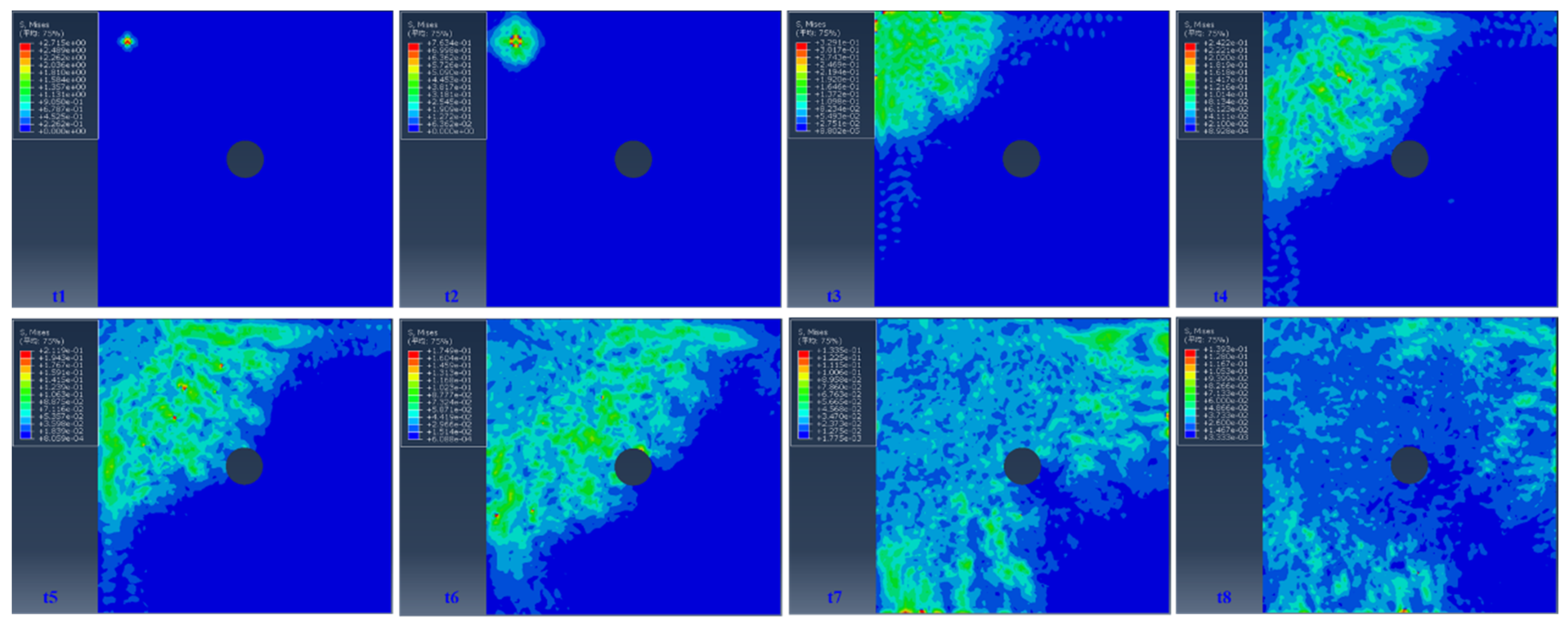
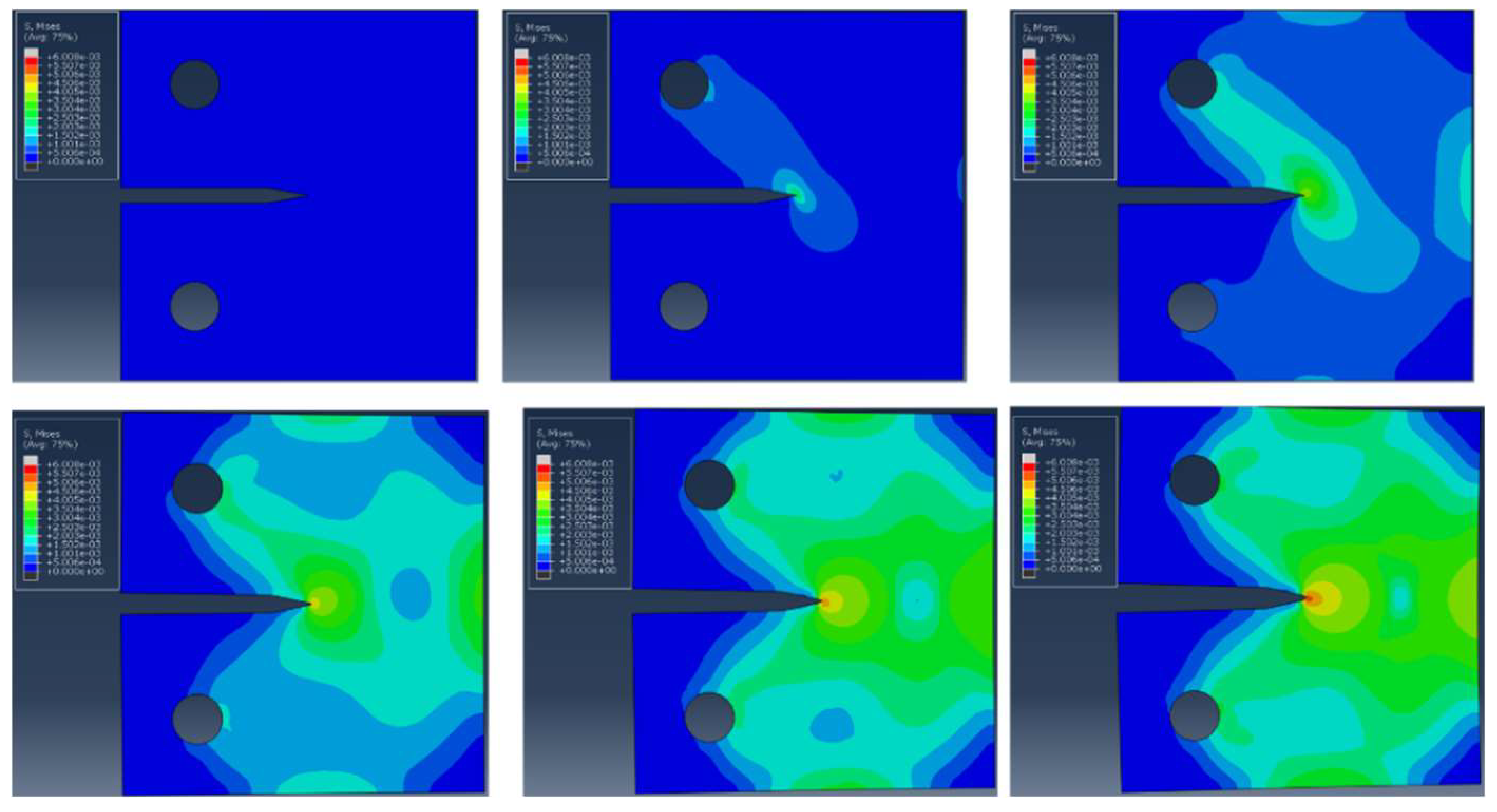

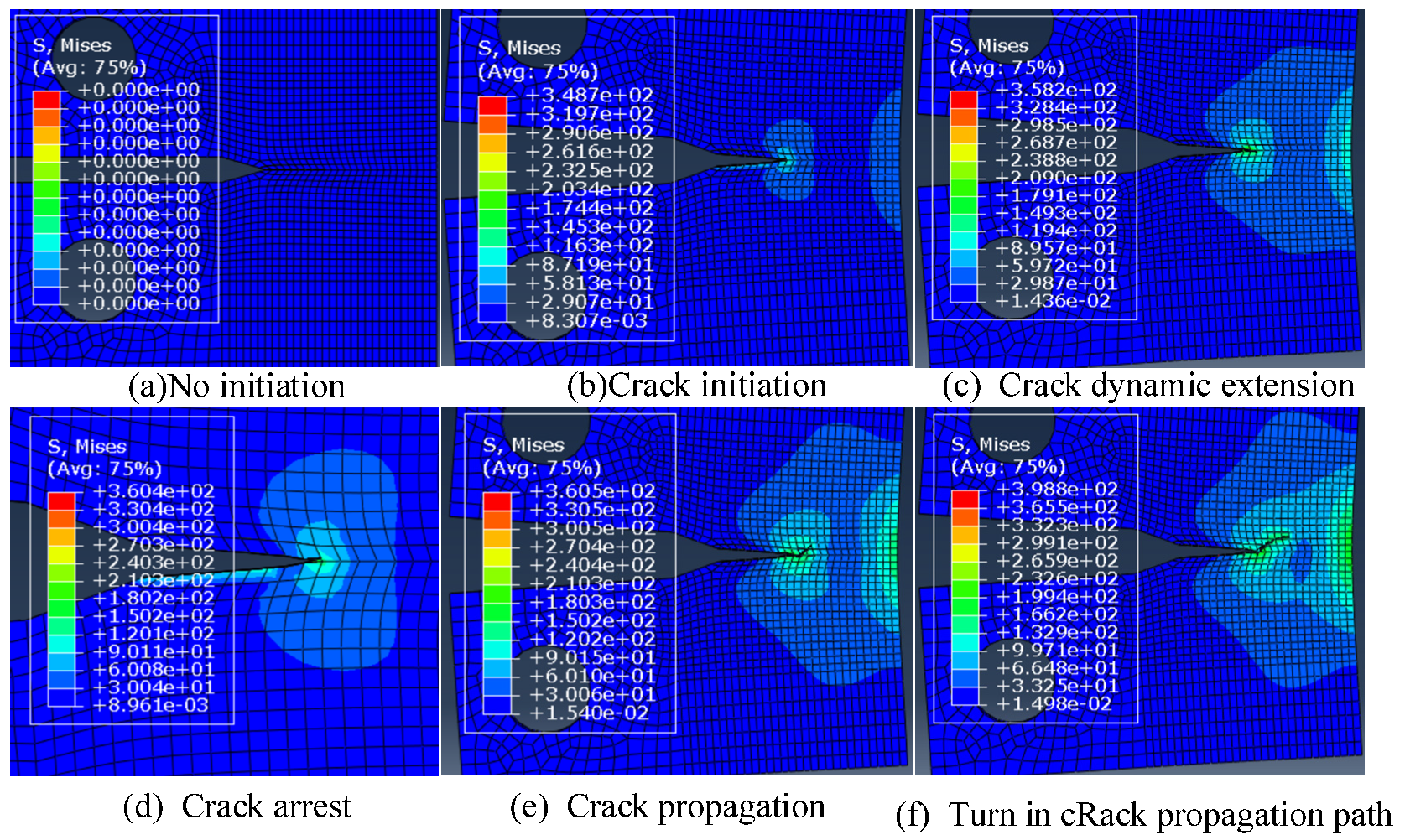
| Johnson-Cook Model | A(MPa) | B(MPa) | n | C | m |
|---|---|---|---|---|---|
| 370.4 | 1798.7 | 0.73315 | 0.0128 | 1.5282 |
| 2A12T4 | Value |
|---|---|
| Density (ρ) [kg/m3] | 2800 |
| Modulus elasticity (E) [GPa] | 68.3 |
| Poisson ratio (ν) | 0.33 |
| Yield stress (MPa) | 330 |
| Failure strain | 0.12 |
Publisher’s Note: MDPI stays neutral with regard to jurisdictional claims in published maps and institutional affiliations. |
© 2021 by the authors. Licensee MDPI, Basel, Switzerland. This article is an open access article distributed under the terms and conditions of the Creative Commons Attribution (CC BY) license (https://creativecommons.org/licenses/by/4.0/).
Share and Cite
Peng, Y.; Liu, Y.; Zhang, W. Analysis of Dynamic Response Behavior of Crack under Impact Stress Wave. Metals 2021, 11, 1920. https://doi.org/10.3390/met11121920
Peng Y, Liu Y, Zhang W. Analysis of Dynamic Response Behavior of Crack under Impact Stress Wave. Metals. 2021; 11(12):1920. https://doi.org/10.3390/met11121920
Chicago/Turabian StylePeng, Yan, Yang Liu, and Wei Zhang. 2021. "Analysis of Dynamic Response Behavior of Crack under Impact Stress Wave" Metals 11, no. 12: 1920. https://doi.org/10.3390/met11121920
APA StylePeng, Y., Liu, Y., & Zhang, W. (2021). Analysis of Dynamic Response Behavior of Crack under Impact Stress Wave. Metals, 11(12), 1920. https://doi.org/10.3390/met11121920






